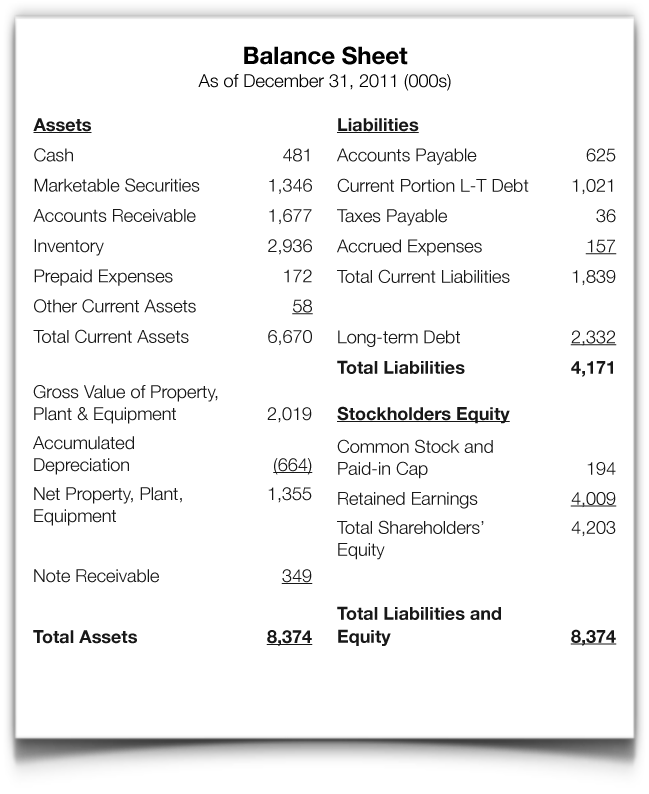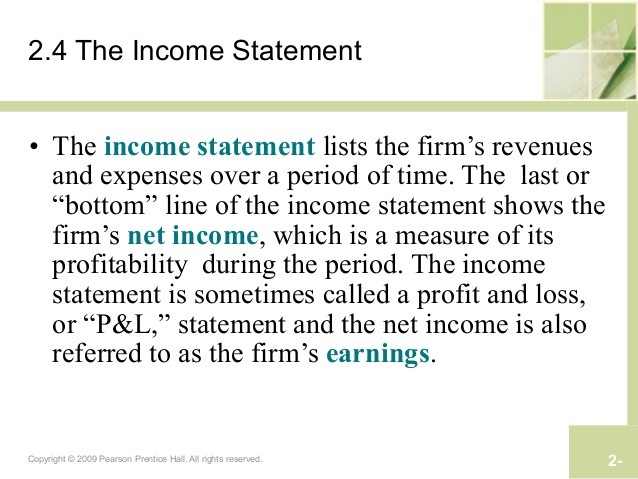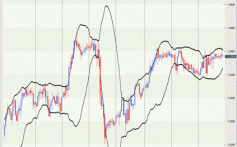Introduction to Financial Statements Income Statement Analysis
Post on: 16 Март, 2015 No Comment

3 Ways to Learn:
Transcript for the video:
In the prior video, we provided an overview of the income statement. In this video we explain how to do some simple analysis of the information on an income statement.
INCOME STATEMENT
We are using the same income statement from the last video, but we have now added some line numbers to the left of each row. These numbers are there to help you understand which items we are using in our calculations, and how to do the calculations that end up giving us insights into the income statement.
GROSS MARGIN
Since the income statement is a measure of profitability, the first thing we want to do is analyze some of the profitability measures. The first one is gross profit, which is the profit the company made on sales after cost of goods sold. We are going to calculate the gross margin to look at profitability as a percentage. The gross margin is calculated by dividing the gross profit of $1,987,000 by revenue of $11,892,000 and we see that the gross margin percent is 16.7%. Now whether 16.7% is good or bad is something we can’t tell just yet. Well discuss how to determine if this is good or bad in a moment, but first we will define a few other profitability ratios.
OPERATING MARGIN
The second profitability measure to analyze on the income statement is operating profit. We calculate the operating margin by dividing operating profit of $752,000 by total sales of $11,892,000, and that shows that the operating margin was 6.3%.
PRETAX MARGIN
The next profitability measure pretax income. To calculate the pretax income margin, we divide pretax income of $881,000 by sales, of $11,892,000, and we end up with a pretax margin of 7.4%.
NET PROFIT MARGIN
The final margin that we can calculate on this income statement is the net income margin. We divide net income of $397,000 by total sales of $11,892,000 and we have a profitability margin of 3.3%. This 3.3% profit margin means that for every thousand dollars of sales the company generates a profit of $33.
EBIT & EBITDA
There are a couple of other very common income statement calculations. One is called EBIT and one is called EBITDA. EBIT stands for earnings before interest and taxes, which essentially is operating profit. EBITDA stands for earnings before interest, taxes, depreciation, and amortization. We will discuss these items in greater detail in our financial analysis videos, but we wanted to include the definitions and calculations her for your reference.
QUICK SUMMARY OF THE RATIOS
So here is a quick summary of the ratios we calculated. The gross margin is 16.7%. After taking into account operating expenses, the operating margin is 6.3%. The pretax margin increases to 7.4% as a result of having some non-operating income. The Net Income margin drops by more than half to 3.3% as a result of taxes and extraordinary items.
GOOD PERFORMANCE?
Now that we’ve calculated some ratios, we need to do some analysis. For example, is the 6.3% operating margin good? Well we need to be able to compare it to something to determine if it’s good or not. The first thing you can do is compare it to other companies doing the same thing. If other coffee cup manufacturers have an operating margin of 15% then clearly this company is not doing something right and the 6.3% is not a good number. However, if other coffee cup manufacturers have an operating profit margin of 2%, then the 6.3% says this company is doing something very special and very good. We explain how to get information on other companies in our Financial Statement Analysis series.
Another way to compare the operating margin is to take a look at how this one company has done over time. Is this 6.3% higher than past years (in which case the company is becoming more profitable) or is it lower? Typically we want to compare three years, and sometimes we want to compare quarter to quarter as well as year to year. Whenever we’re doing this type of comparison, we are looking for trends and major changes. So if it’s relatively consistent that’s good, and if it’s improving, that’s better. But if there are major changes or it’s going up and down that means you want to learn more.

INCOME STATEMENT TRENDS
So let’s take a look at the performance of this coffee cup manufacturer over the last three years. We can see that sales were 9.1 million in 2009, increasing to 10.5 million in 2010 and almost 11.9 million in 2011. That looks really good; sales are going up each year. Now when we look at the change in sales we can see that in 2010 revenue increased by 1.37 million and a little more in 2011. So not only is it going up, it’s going up each year. But let’s look at one other item: the sales growth rate. We can see that the 1.37 million increase in 2010 represents a 15% growth rate over 2009, but in 2011, even though sales went up even more, the growth rate dropped a little bit, down to 13%. In this example, the drop in growth rate is not a huge issue. However, you can see that when you look at information in different ways you get different insights. While everything may look good at first, you may actually find that when you look at it from a different perspective, there issues of potential concern.
OPERATING MARGIN TREND
Now let’s take a look at perhaps the most important margin item, which is operating margin. And in this case we again see that operating profit was going up each year by small amounts, but the actual operating margin was going down from 10% to 9% down to 8%. Now we can see that most of this is really driven by the gross margin, which was declining, and that’s what’s causing the operating margin to decline. In other cases you might see that the gross margin percent was staying the same but operating margin was going down, which means that operating costs as a percentage of sales were going up. This could mean greater investment in R&D, greater costs in sales and marketing expenses, or maybe increases in general overhead expenses.
NET PROFIT MARGIN
Finally, we want to take a look at trends with the net profit margin, since this incorporates all profitability measures for the company. We see that it has been steadily declining for this company, with the big drop in 2011 as a result of the extraordinary charge.
RATIOS PROVIDE INSIGHTS
The basic income statement analysis techniques shown in this presentation reveal a number of insights about this company. While it is profitable and sales have been growing, there are a number of trends that are of concern. The sales growth rate is declining and margins are decreasing. For a credit manager, it means that this company should be reevaluated when additional financial results are available to see if trends are continuing or if management has found a way to improve results.
Next Video
Our next video in the series is Beginning Balance Sheet Analysis . Remember, you can download the Financial Statement Analysis eBook, which includes over 50 definitions and ratio calculations. It also includes an Excel spreadsheet that will calculate key ratios when you input financial data. If you need debt collection assistance, we are specialists in large business-to-business claims, and we can refer you to other agencies if your needs do not fit with our expertise. Just fill out the Request A Quote form or give us a call.














